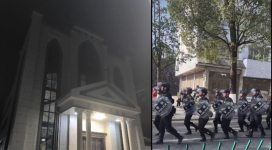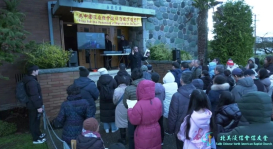
Pockets of protest erupted in different places in the Philippines as former president and dictator Ferdinand Marcos was laid to rest at the Heroes’ Cemetery on Friday in what many people call a sneaky burial.
Marcos was buried with military honors despite petitions from various groups to block the ceremony because of the many human rights violations committed by the former president. The burial came as a surprise to most Filipinos, as details were kept secret until the day of the burial itself.
The administration claimed to have no knowledge of the Marcos family’s plans, but critics question this statement, especially with the military’s participation in the event. The chief of police also released a contradictory statement saying Pres. Rodrigo Duterte was aware of the plan.
Military spokesman Brigadier General Restituto Padilla said they only took part in the ceremony upon orders but didn’t elaborate further.
Philippine Vice Pres. Leni Robredo criticized the ceremony, saying the family went about the sneaky burial like a “thief in the night.”
"Like a thief in the night, the Marcos family deliberately hid the information of burying former President Marcos today from the Filipino people," she said. "This is nothing new to the Marcoses — they who had hidden wealth, hidden human rights abuses and now hidden burial — with complete disrespect for the rule of law."
The vice president said the fact that the ceremony was done with the participation of the military and the police was disturbing.
Students from different schools walked out of their classes and held protests when news of the burial broke out. People also flocked to the historic EDSA Shrine, the site of the first bloodless revolution called ‘People Power’ that ousted Marcos in 1986.
In different provinces across the country, pockets of protests were likewise held to condemn the burial.
Marcos’ burial was carried out 10 days after the Supreme Court ruled that he is eligible to be buried at the Heroes’ Cemetery. With a vote of 9-5 in favor of the burial, the high court said burying the former dictator at the Heroes’ Cemetery is legal and not in conflict with the law.
However, that decision was not final and executory up to 15 days or until motions for reconsideration are resolved.
Pres. Rodrigo Duterte ordered the burial of Marcos’ remains a few months ago to fulfill what he promised during the campaign, saying the strongman deserved to be buried at the said cemetery because he was a former soldier and a former president.
Duterte’s decision was challenged by a petition to block it, but the high court ultimately dismissed the petition.
Supreme Court spokesperson Ted Te said the order to bury Marcos at the Heroes’ Cemetery was not an act of grave abuse of discretion by Duterte, and that Duterte had the power “to reserve for public use and for specific purposes any lands under public domain.”
Pres. Rodrigo Duterte was in Peru for the Asia-Pacific Economic Cooperation on the day of Marcos’ burial.
Marcos was exiled in Hawaii with his family after being ousted by the Filipino people. He died in 1989, and his family was allowed to return to the Philippines in 1991.
According to Amnesty International, during martial law years under Marcos’ rule, about 70,000 people were imprisoned, 34,000 were tortured and at least 3,000 were killed.







